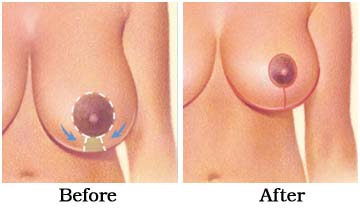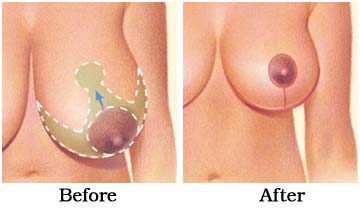Overview
Breast Reduction Surgery
Breast reduction surgery reduces the breast size and weight by making it firmer with smaller areolas. During the surgery the key properties removed from the breast are glandular tissue, fat cells and redundant skin.After the surgery the patient wears a special bra for few weeks to support the breast as they settle into their new shapes. The patient will lose sensation in nipples for some period. Numbness may also cover a part of your body for a short period. It is not recommended for women who desire to breast feed as it may worsen the likelihood of success and the volume of breast milk. Other problems due to the surgery may include, asymmetry, delayed wound healing, fluid retention and altered sensitive to sexual stimulation.
Procedure For Breast Reduction Surgery
A woman may choose to have breast reduction surgery if she has heavy, sagging breasts with low nipples; breasts that are too large in proportion to her body; back, neck, or shoulder pain due to the weight of her breasts; chronic skin irritation beneath her breasts; indentations in the shoulders due to her bra straps; or one breast that is noticeably larger than the other.Method Of Breast Reduction Surgery
The most common method of breast reduction involves making several incisions.- First, an incision is made above and around the areola.
- Then, incisions below and to the sides of the areola and along the crease line beneath the breast allow excess skin and fatty tissue to be removed.
- Then, the areola is reduced in size and is shifted with the nipple to a higher position, usually without affecting attachment of the functional tissues below.
- Finally, the skin of the lower breast is closed and sutured below the areola to give the breast its new contour.
Breast Reduction Procedural Steps
Breast reduction surgery is usually performed through incisions on your breasts with surgical removal of the excess fat, glandular tissue and skin.In some cases, excess fat may be removed through liposuction in conjunction with the excision techniques described below. If breast size is largely due to fatty tissue and excess skin is not a factor, liposuction alone may be used in the procedure for breast reduction.
The technique used to reduce the size of your breasts will be determined by your individual condition, breast composition, amount of reduction desired, your personal preferences and the surgeon’s advice.
Step 1 - Anesthesia
Medications are administered for your comfort during breast reduction surgery. The choices include intravenous sedation and general anesthesia. Your doctor will recommend the best choice for you.
Step 2 - The incision
Incision options include:
- A circular pattern around the areola

- A keyhole or racquet-shaped pattern with an incision around the areola and vertically down to the breast crease

- An inverted T or anchor-shaped incision pattern

Step 3 - Removing tissue and repositioning
After the incision is made, the nipple-which remains tethered to its original blood and nerve supply-is then repositioned. The areola is reduced by excising skin at the perimeter, if necessary.
Underlying breast tissue is reduced, lifted and shaped. Occasionally, for extremely large pendulous breasts, the nipple and areola may need to be removed and transplanted to a higher position on the breast (free nipple graft).
Step 4 - Closing the incisions
The incisions are brought together to reshape the now smaller breast. Sutures are layered deep within the breast tissue to create and support the newly shaped breasts; sutures, skin adhesives and/or surgical tape close the skin. Incision lines are permanent, but in most cases will fade and significantly improve over time.
Step 5 - See the results
The results of your breast reduction surgery are immediately visible. Over time, post-surgical swelling will resolve and incision lines will fade. Satisfaction with your new image should continue to grow as you recover.
After Breast Reduction Surgery
After a period of bruising and swelling, the incision lines begin to fade and the breasts take on a more natural shape.Following breast reduction, many women experience significant relief of discomfort, and are able to wear a greater variety of clothing styles and can participate in more physical activities.
Breast Reduction Surgery Risks
There are several potential complications associated with this procedure that should be discussed with a doctor prior to surgery.Complications And Side Effects
You should expect to feel tired and you will have breast pain. This is normal!
Your surgeon will give you a prescription antibiotic ointment and oral painkiller to ease you through the first few days after surgery. You should avoid heavy lifting at all costs, as this can promote scarring.
It's important to note that a breast reduction will cause scars as a normal side effect. However, the scars can be made worse if you lift heavy objects prematurely. Though they are rare, some people may experience certain complications such as inadequate healing of the nipple area, which may require a skin graft.
Recovery And Follow-Up Care
You will need to take at least one week off from work or school. Some patients require two weeks, but each situation varies. Your surgeon will instruct you on follow up appointments to remove bandages and sutures.If you are a physically active person, you will not be able to resume your activity for at least one month after surgery. It's very important that you realize the emotional impact of surgery: a lot of people experience depression, but this is normal! Make sure you communicate with your doctor about all your concerns.
For more information, medical assessment and medical quote
as email attachment to
Email : - info@wecareindia.com
Contact Center Tel. (+91) 9029304141 (10 am. To 8 pm. IST)
(Only for international patients seeking treatment in India)










